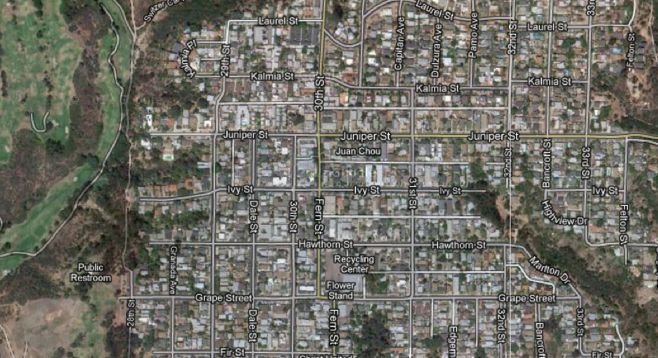 Facebook
Facebook
 X
X
 Instagram
Instagram
 TikTok
TikTok
 Youtube
Youtube

Heymatt:
Why in the world does 30th Street morph into Fern Street between Juniper and Ash streets? Not only that, 30th doesn’t disappear during its run as Fern but actually continues as an entirely separate and parallel street one block to the west of Fern. I can understand that it would be a huge hassle to fix it, i.e. rename Fern as 30th and then rename the western section of 30th as Fern, but why did this happen in the first place?
— Neil Allen
If you look at USGS maps ca. 1900, South Park has about 30 houses. By 1930, the entire neighborhood as you know it was planned and developed, so it looks like you have turn-of-the-century city developers to blame for your annoyance. The biggest difference is that there were fewer trees then. One of the big factors shaping early development in the neighborhood was the streetcar system that made its way up from Golden Hill and, eventually, over Switzer Canyon and into North Park. The trolley’s route was up 30th Street and 30th was made broader and wider to accommodate the higher traffic. Even today, 30th is ten feet wider. My understanding is that 30th was planned as the streetcar route, despite not being a perfectly straight shot. The idea that the main thoroughfare should be contiguous, even if a bit wandering, smacks of early city planning. Flappers en route to speakeasies had less choice in travel since not everybody had a car, so it made sense for the street to follow the trolley rather than the other way around. The topography of the land would have had something to do with it as well, since the grade there is fairly aggressive.
Sadly, the planners didn’t plan for us all having our own cars. Now, it seems natural to go straight on Fern when driving through South Park. Planning reports from the 1980s indicate that Fern Street saw three times as much vehicle traffic as the corresponding section of 30th and not much has been done to change that.


Heymatt:
Why in the world does 30th Street morph into Fern Street between Juniper and Ash streets? Not only that, 30th doesn’t disappear during its run as Fern but actually continues as an entirely separate and parallel street one block to the west of Fern. I can understand that it would be a huge hassle to fix it, i.e. rename Fern as 30th and then rename the western section of 30th as Fern, but why did this happen in the first place?
— Neil Allen
If you look at USGS maps ca. 1900, South Park has about 30 houses. By 1930, the entire neighborhood as you know it was planned and developed, so it looks like you have turn-of-the-century city developers to blame for your annoyance. The biggest difference is that there were fewer trees then. One of the big factors shaping early development in the neighborhood was the streetcar system that made its way up from Golden Hill and, eventually, over Switzer Canyon and into North Park. The trolley’s route was up 30th Street and 30th was made broader and wider to accommodate the higher traffic. Even today, 30th is ten feet wider. My understanding is that 30th was planned as the streetcar route, despite not being a perfectly straight shot. The idea that the main thoroughfare should be contiguous, even if a bit wandering, smacks of early city planning. Flappers en route to speakeasies had less choice in travel since not everybody had a car, so it made sense for the street to follow the trolley rather than the other way around. The topography of the land would have had something to do with it as well, since the grade there is fairly aggressive.
Sadly, the planners didn’t plan for us all having our own cars. Now, it seems natural to go straight on Fern when driving through South Park. Planning reports from the 1980s indicate that Fern Street saw three times as much vehicle traffic as the corresponding section of 30th and not much has been done to change that.
Comments